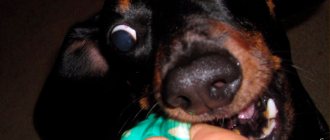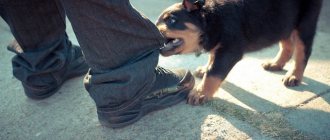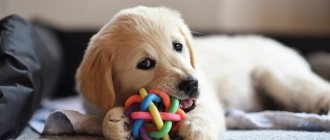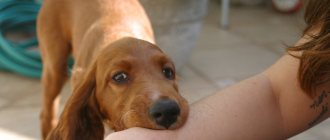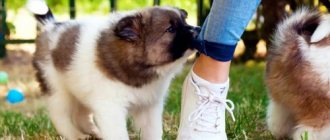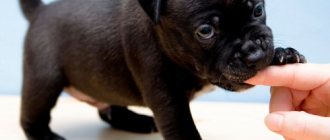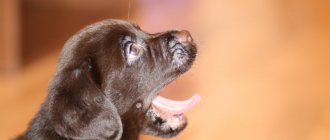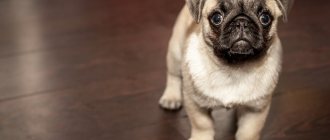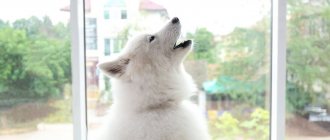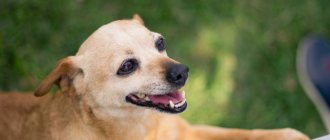For predators, which include dogs, biting is quite natural. This is how they express their emotions and react to stimuli. But if your pet’s behavior is not corrected in time, it can subsequently cause serious injury. The reasons for a dog's unacceptable behavior may be lack of training or instinctive reactions. It is important to teach from an early age
puppycontrol yourself so that it is manageable and does not pose a danger to others.
Why does a puppy bite?
To solve the problem of a biting puppy, you first need to identify the reasons for the unacceptable behavior. By and large, there are four of them: based on them, tactics are selected to eliminate the problem, which can subsequently lead to disobedience and aggression of the animal.
Changing teeth
At the age of 4-6 months, puppies chew on everything around them, because their permanent teeth grow. To calm the dog, you need to give it its favorite treat and be sure to chew something. Soft toys made of nylon, chewing ropes, plastic sticks and special bones are suitable. You can also offer the puppy a cold cloth, which will reduce swelling and pain in the gums and relieve general discomfort.
Game or communication
The puppy constantly bites arms and legs to attract attention. Small pets have not yet developed a system of signals for communication with their owner. There is nothing wrong with this - with age and upbringing, the dog acquires the necessary skills for living with people, finds other ways to express its desires and emotions.
Breed predisposition
There are hunting and service dog breeds that are prone to grabbing living creatures. Among them are huskies, huskies, dachshunds, Rottweilers, Russells, Cairn Terriers and puppies born in an enclosure. They require a more careful approach to education. Owners often need the help of a professional dog handler. Regular training allows you to grow your four-legged pet into a friendly and obedient dog.
Instinct
The puppy often bites intuitively, trying to impose his own rules of the game on the owner or demonstrate his superiority. By nature, all animal instincts are inherent in him. When carried away by a game, a dog can unintentionally cause pain to a person, leaving scratches on his hands with his sharp teeth. This behavior is manifested by a number of signs:
- the dog bites the legs or arms in response to unpleasant actions, for example, when a bowl of food is rearranged or a toy is taken away;
- the puppy bites and growls, warning of its displeasure;
- the pet does not tolerate any prohibitions and acts as it wants.
You shouldn’t let the situation take its course - if your puppy bites your hands, ask your dog handler how to wean your pet from the bad habit. Sometimes a video on the Internet, specialized literature, or contacting an experienced dog breeder helps.
Do not hope that the dog will grow up over time and everything will work out on its own. In 80% of cases, such behavior without intervention from the owner is only reinforced, and in the future serious corrective work will be required to educate an adult dog, which does not always end successfully.
Why might an adult dog bite?
Natural instinct forces an adult dog to show aggression to protect itself, its owner, protected territory, property, etc. The problem can be eliminated by identifying the cause and selecting the right tactics.
A game
Pets explore their surroundings throughout their lives. They love to play with people too. The dog bites the owner's hands, grabs clothes, legs - using his mouth and teeth, inviting him to play.
Such behavior is touching when the puppy is no more than 2 months old, and an adult animal’s teeth can cause serious injury. You need to teach your dog to control his bite force at an early age. During the game you should behave carefully, demonstrating to the dog the sensitivity of its own skin.
To attract attention
An adult dog, realizing that the owner does not pay attention to it every time he whines, is able to bite his arms and legs. You cannot console the animal; every bark and bite must be punished with the command “Ugh!”, since the dog must wean itself off the bad habit. When your pet realizes that this method of attracting attention does not work, he will stop doing it.
Protection - yourself, property or owner
Many people choose working or fighting breeds to protect their home and the people living in it. But security qualities also have a downside. Thus, an adult dog thinks that property can only be defended by attack. Possessions can include favorite toys, a food bowl, an enclosure, or even a loved one. For this reason, all family members are at risk.
Regular training with a professional dog handler, who will correct the correct behavior of an adult dog in a given case, will help you avoid an unpleasant situation. With a large guard or fighting breed dog, it is recommended to take OKD and ZKS courses.
Display of aggression
Even the kindest and most patient four-legged friend may not be able to stand it when he is improperly kept, raised and trained, unduly encouraged or punished, pushed, shoved, pinched and constantly squeezed by children, provoked by the presence of other animals nearby. Sooner or later the dog will get tired of the disrespectful attitude and will bite. Preventing aggression from an adult animal is simple:
- learn to understand your pet;
- spend as much time as possible on training and socialization;
- Respect the dog, teach your children to treat it carefully and with love.
It is only partially possible to retrain an adult dog. Psychological foundations are laid in an animal up to a year. During the first 12 months of life, you should make every effort to become an authority in the eyes of your little pet.
How quickly you can stop your dog from biting his arms and legs will determine his predictable behavior and peaceful stay in the family. You shouldn’t refuse the help of a dog handler: he will select effective training tactics for a specific breed and suggest the correct course of action.
Methods of influence
Not all dog owners can raise a growing pet correctly. As soon as a pet starts biting during play, it is already an obstacle. Certain recommendations must be followed:
- It is necessary to avoid those games in which the puppy may accidentally bite the owner.
- If the dog bites the owner during play activity, then the jaw must be opened very carefully. You cannot punish your pet physically.
- The pet is good-natured towards all residents of the house. If it turns out that the puppy bit the owner, then you can pretend that it is incredibly painful. It is even recommended to pretend that the person is crying, after which he quietly leaves the puppy. He will understand that he has caused pain to the owner and this should not be done.
- The pet does not immediately perceive the person as a leader, and therefore does not obey him. This often happens due to improper upbringing. Training the puppy will help establish the dominant role of the owner. The pet will not bite during play and without reason.
Many argue that a barking puppy cannot bite a person, but in reality it all depends on age, gender and breed. If your pet begins to bare its teeth and bark loudly, then you need to look menacingly into its eyes, showing your importance.
How to stop a puppy from biting
A perky and endlessly loyal four-legged friend has appeared in your home. But what to do if the puppy bites, leaving bleeding scratches on the arms and legs with sharp teeth? Engage in correcting the behavior of an aggressive animal, applying maximum patience, attention and finding a special approach. Initially, you need to identify the cause of the bad habit.
During the game
A puppy separated from its brothers ends up in the home of people with their own life experience and the habit of biting in the process of communication and active play. When an animal needs the owner's attention, he runs up and quietly bites his hands or feet. In response, the person reacts negatively, and the pet perceives this as a continuation of the game and bites even harder and more painfully.
Or, on the contrary, a person encourages such behavior, plays with the dog, and begins to persuade it not to play around. The dog understands the impunity of its action, and it develops a tendency towards unmotivated aggression towards people and animals. If the owner does not identify the problem early and correct it, it could become a serious problem in the future.
The following methods of education are effective:
- Do you see that your pet wants to bite? Hide your hands behind your back. After he closes his mouth, snap your fingers and give him something tasty. This needs to be repeated several times. Then, before hiding your hands, tell the puppy: “Shut your mouth!”
- If your dog bites while playing, offer him a soft toy instead of your hand.
- When the puppy is resting, bring your fist to his face. If he doesn't bite, snap your fingers and give him some tasty food. Then move your hand in front of his muzzle: if he doesn’t bite again, then encourage him further. If the dog rushes, you need to hide your hands behind your back and command “Ugh!” or “You can’t!” (there should be only one command, choose in advance which one you will train the dog). This procedure should be carried out regularly. The hand should be moved at different distances from the muzzle.
Puppies are very smart, and they usually quickly wean themselves from bad habits. Particularly obstinate breeds can be pacified only by proving their superiority.
Distraction
There is no need to pamper the puppy and give him a lot of attention - otherwise he will pester you every minute, whining and biting your fingers. If you can't leave your dog in a closed room for a while, distract his attention with a bone or toy so that he can entertain himself.
You can also get involved in the game: with the help of a taffy toy, “compete” with the animal, help throw out accumulated energy, and develop good physical shape. A correctly selected item can become a pet’s favorite; in addition, it can keep furniture and shoes intact, completely satisfying the need to “chew something.”
A fun, active game is an excellent opportunity to establish friendly and warm relationships with the puppy, but any attempt to bite into the owner should be stopped immediately. This is taboo!
Calm
When a dog is scared, feels threatened, is sick, or is overly active, he may bite. An overexcited puppy needs to be calmed down. Screaming and slapping will not help, as the animal may perceive this as your fear or desire to play. Stroke the dog's fur, speak quietly, behave calmly.
There are situations when a puppy gets too playful and bites, how to wean him from expressing emotions too violently? Calm him down, for example, sit him on your lap, or gently press him to the floor for a while. Repeat the command “Ugh!”, “No!” two or three times. and wait until the puppy has completely calmed down.
To consolidate the results, it is recommended to repeat the educational procedure regularly. The action can be enhanced by a reprimanding and stern look, indicating your authoritative position in the hierarchy.
Methods of punishment
Biting is a natural behavior for puppies; they learn about the world around them through this variation of communication and play. And if you start punishing for this, hurting each time, you will get a enslaved adult dog, which will subsequently have a hard time opening up and living peacefully among people and other animals. Physical impact can cause many negative consequences, including aggression. But unacceptable behavior cannot be ignored.
Several effective ways to calm your pet:
- when a dog attacks the legs of a passing person, hangs on his trousers, take the animal by the withers, shake it lightly and strictly say “No!”;
- A light slap on the croup area with a newspaper or rag and a loud command “Ugh!” will help put the naughty guy in his place;
- Dog bites as an invitation to play do not need to be punished, but if the pet goes beyond what is permitted, holding it in one position for 3-5 seconds will help to calm it down.
In cases where a tailed friend does not show respect for his owner and does not follow the commands “No!” and “Ugh!”, a professional dog handler will help correct the behavior. Educational work will bear fruit, and the dog will grow up loyal, sociable and obedient.
Unacceptable techniques (myths)
So, let's start with the main myths or what you absolutely cannot do!
Myth No. 1 is democratic. It is proposed to let the situation take its course. Arguments like “It will outgrow. Let him scratch his teeth,” we dismiss it right away. The dog will not outgrow and understand until you teach it to him. You wouldn’t demand from a baby that he understands that he doesn’t need to put his hands in his mouth. At a minimum, you will give information that this cannot be done. And it is advisable to present information in such a way that a puppy, like a child, understands it. And I remembered. Maybe not right away, but a start must be made.
Myth No. 2 is sadistic. The following options are offered to combat the habit of biting, such as slapping the nose, butt and other parts of the body. Don't you dare! Firstly, it is strictly forbidden to beat a dog for the following reasons: you love it (toy terrier, chihuahua) very much - that’s one thing, the dog can harbor a grudge - that’s two things, angry shouts and a slap can provoke the dog even more, provoke further attacks - that's three. There is no need for violence, it has never led to good results. Secondly, the nose is a very painful place for a dog. Will a hand really rise to hit the baby? I think no. Especially if you arm yourself with patience and knowledge of the right techniques.
Myth No. 3 – liberal. “Smoothly bring the game to nothing.” This number will not work. It is clear that the dog will stop biting you as soon as the game ends. But it is important for us not to avoid the problem, but to solve it. You should not immediately stop trying to bite you, but let the dog understand that such behavior is unacceptable.
How to stop an adult dog from biting
Nature has given dogs the potential to show aggression. Therefore, protecting oneself and the owner, territory and property, hunting is a normal phenomenon. But when biting the hands and feet of household members becomes an everyday and unreasonable occurrence, correction of incorrect behavior is required.
An adult animal can only be partially changed; it is difficult to re-educate. Psychological foundations are laid before a year. You will have to make every effort and take the help of a professional dog handler to become an authority on your four-legged pet.
Domination
You need to teach your dog not to bite from an early age. By the age of 2 months, the puppy must learn that he cannot dominate his owner and family members. The person needs to show the dog who is in charge and not give up his leading position.
Particular attention should be paid to feeding. If you manage to take the piece you like from the bowl of a eating dog, then according to the laws established in the animal world, you are a leader who must be obeyed.
An important point in training is the division of territories. The animal must sleep in a designated place, and the bed is the property of the owner; penetration and seizure of it is unacceptable. The dog clearly knows: whoever occupies the territory of the leader becomes the leader.
It is impossible to allow the dog to dominate the family, otherwise it will definitely not be possible to raise him the way you want. Each command will be accompanied by growling and aggression from the dog.
A 6-12 month old male teenager requires stricter training. After biting an arm or leg, instead of screaming and hurtful words, use the “wolf technique” - when the puppy starts to snap and growl, lightly press him to the floor or lift him on a leash and shake him. This must be done carefully so as not to strangle the dog or break its neck. After the pet goes limp - he needs to be released - he has already recognized your superiority and leadership in the family.
Socialization
Socialization of a pet is acclimation to society and society, and not selective, but modern, the most ordinary, often fussy and noisy. The animal will constantly have to deal with different weather, other animals and people.
The main assistant in shaping the dog’s correct behavior will be daily walks with the owner. You can walk your dog outside immediately after the end of the vaccination quarantine. The socialization algorithm is the same for all breeds, it is as follows:
- Initially, the animal is introduced to the territory near the house (10-25 meters), 15 minutes is enough for a walk;
- after 3-4 days, the walking radius expands; it is better to avoid meeting other animals, as the dog gets used to the leash and the sounds of the city;
- after 14 days, the animal can be walked along the street longer, introduced to other dogs and basic commands;
- Do not forget about an adequate attitude towards people: the dog should not be afraid of them, growl, rush and bite;
- in a month you can take your pet in a muzzle and on a leash on public transport, go on a visit, to a store, to the market and to other public places.
Accustoming to society and society does not tolerate haste and fuss. Never introduce your dog to several new things at once. Let him adapt to one thing, after which he can continue acquaintance and education. These rules apply to both a puppy and an adult dog adopted from a shelter.
Fighting aggression
If a dog attacks due to an attack of aggression, it growls and grins, and there is a strange shine in its eyes. In addition to this, other gestures are manifested - a raised tail and ears, tousled fur on the back and neck, a close look at the object of attack.
To prevent dog aggression, remove the motivation, that is, coexist peacefully with the animal and do not provoke conflict situations with your attitude and behavior. When your dog shows aggression by growling, resisting, or lightly biting his arms and legs, be firm and force him to submit.
By completing a training course at the center, you will be able to acquire the necessary skills in hierarchical relationships with your pet. A professional dog trainer will tell you how to stop a dog from biting arms and legs, and will develop an effective training method for a specific breed. To avoid being bitten in conflict situations, the animal must be put on a muzzle and a leash, but the dog must be accustomed to them in advance.
Trainer-led training courses
For a comfortable and safe life next to humans, almost all dog breeds (except small four-legged ones) require a general training course, also known as OKD. This is especially true when the breeder is inexperienced. Raising a dog will require the owner to be attentive, precise in his actions, and strictly adhere to the training methodology. Training courses under the guidance of a professional dog handler will allow you to timely and clearly manage the actions of the animal in everyday life, and raise a calm, obedient and friendly pet.
Breed predisposition
Some breeds have pronounced instincts and at the same time a high predisposition to bites. These include hunting, fighting, hounds and other large working breeds. Such dogs need special education, a certain level of activity and correction of aggressive behavior from an early age.
Important! If a dog does not obey, it can cause damage to both its owners and strangers. In this case, it makes sense to contact a professional dog handler.
Bites of decorative breeds and small dogs should also not become habitual behavior and should be encouraged by the owner. Particularly biting breeds include the following:
- dachshund;
- chihuahua;
- Toy Terrier;
- Pomeranian Spitz;
- pit bull;
- bull terrier;
- Rottweiler;
- chow-chow;
- Cocker Spaniel.
Errors and prohibited measures
Under no circumstances should you achieve your goals by beating, hysterical screaming and loud swearing. Such behavior can cause aggression in the animal, including attacks and bites, and at the same time completely discourage learning. In addition, such an approach reduces the authority of the owner in the eyes of the animal.
The main mistake of the trainer is incorrect behavior, which is why the development of the necessary skills is inhibited, and undesirable skills, on the contrary, are learned very well.
Common mistakes owners make when rehabilitating bites are:
- Ignorance that the dog is capable of specifically understanding human speech. The trainer changes commands, and for each command the dog develops new skills. If the command sounds like “Sit,” then next time you cannot say “Sit down,” “Sit down,” etc. For the animal, each new command sounds like a completely different sound stimulus.
- When correcting behavior, you cannot respond with any emotions to the animal’s excitement. Even affection and encouragement can harm the process. All reactions must be thoughtful and calm.
- It is forbidden to punish a dog for biting with a walk and food. All basic needs must be satisfied (even if the dog does not obey at all), since his health in the future depends on this.
A rough attitude causes fear in the animal and can lead to increased aggression, development of nervousness and anxiety.
Training a four-legged pet requires the necessary skills and knowledge. And if you are not confident in your own abilities, it is better to entrust dog training to a professional dog handler. He will develop an effective training methodology for a specific breed and help consolidate the acquired knowledge in practice. After completing the classes, you are guaranteed to get the required result, that is, an obedient and friendly dog.
Obesity treatment
Almost all pugs love to eat.
They are ready to stand next to you as soon as you sit down at the table, and with their appearance of a “hungry dog” arouse the pity of others, asking for a tidbit. There is no need to follow the lead of these cute creatures. It is necessary to create a strict feeding regime and the necessary diet. Small puppies should eat 3-6 times a day, with a single dose calculated for every 450 grams of weight, about 28 grams of food. That is, with a weight of 1 kg it will be about 61 grams.
For an adult pug, 28 g for every 1 kg of weight. So, with a weight of 4.5 kg, you need 142 g of food per meal, once or twice a day. Veterinarians advise prompt treatment of obesity in these dogs.
If the dog is healthy, it is energetic and active! Also a visual sign of the correct weight and lack of fat for a girl is a slightly outlined waist.
You shouldn’t be moved by looking at a plump pug, as excess weight can lead to a reduction in the pet’s life expectancy. This may lead to a risk of cardiovascular disease.
Pug obesity can appear due to hormonal imbalances, chronic stress, and endocrinological disorders. You should take your pet to a specialist who will determine the cause of excess weight and tell you whether he needs a diet.
If the doctor still determines that your pug is obese, you need to switch to “diet food”.
It is worth starting by gradually cutting back portions, reducing the number of feedings until the dog stops gaining weight.
Physical activity is also necessary, but gradual, starting from short walks to running. A pug that has returned to form will delight you with its lively disposition, jumping and running.
Many people are oblivious to what their pet eats, but what they may be giving is not always good for their dog's stomach and liver.
Moreover, a dog like a pug differs from other breeds in that it has problems in the respiratory system - severe shortness of breath. In addition, they may experience increased stress on the joints, and as a result, lameness and arthritis, deformation of the ligamentous apparatus.
Therefore, it is important to decide on the feeding regimen and diet, and in no case give tidbits between meals, strictly observing the regimen. It is necessary to weigh your pet more often, have it examined by a specialist, and take the necessary tests.
Nutrition should be balanced and contain:
- lean poultry meat;
- cereals and legumes;
- white fish;
- berries, fruits and vegetables.
If the examination reveals some kind of disease, then the pug should lose weight under the supervision of a doctor.
NOTE! Physical activity is also necessary for the dog, but it must be introduced gradually, starting with short walks and gradually increasing them by 1.5-2 times. An active, mobile pug is the key to his long life. Thanks to you and your proper care for him, the pug will delight you and give you good and good emotions
Thanks to you and your proper care for him, the pug will delight you and give you good and positive emotions.
What to do if a dog bites relatives
It is necessary to distinguish between when a dog is showing aggression towards someone and when it is simply playing. When biting in a friendly manner, animals do not use their teeth with all their might, but only lightly bite the enemy. They can make deep sounds that do not sound like growls.
It’s another matter if the dog begins to show aggression towards a relative: he growls or barks loudly, bares his teeth, his fur stands up. In these cases, it is necessary to take the pet away, after putting on a muzzle. You cannot punish the dog, but you must strictly explain that such behavior without reason (without protecting yourself, property or the owner) is unacceptable.
To avoid trouble while walking, it is necessary to socialize the dog. She must react calmly to other people and animals - for this, from puppyhood, walks are undertaken in areas with a concentration of other dogs, crowded parks and squares.
The principles of behavior in the circle of relatives should be instilled in the pet using the same methods as in relation to humans. A dog who knows the commands well will avoid a quarrel with another individual by obeying the owner.
